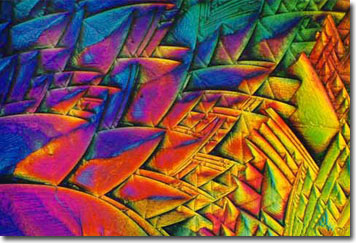Loes Modderman
Resorcinol
Resorcinol is a versatile chemical that is widely used as a chemical building block. Although resorcinol is naturally occurring in a variety of plants, algae, mosses, and fungi, synthetic forms of the substance can be fabricated in large quantities by fusing benzenedisulfonic acid with caustic soda.

|
View another digital image of recrystallized resorcinol taken with the optical microscope. |
Resorcinol-based resins possess exceptional adhesive properties and frequently serve to chemically bond steel or fiber cords to rubber in such products as tires. High-performance lumber composites, such as laminated structural beams, are likewise held together by adhesive systems comprised of resorcinol compounds.
Resorcinol has numerous applications as a chemical intermediate, and it is commonly used in the production of dyestuffs and pharmaceuticals. In addition, a special dye referred to as eosin, and quite useful in optical microscopy as a cellular stain, is derived from resorcinol. Eosin, or tetrabromofluorescein, is a red dye that is also extensively employed in the production of medicines, papers, pigments, textiles, varnishes, and cosmetics. Microscopists utilize eosin for the purpose of contrast enhancement in detailing cellular structures such as cell granules and nuclei, as well as for highlighting mast cells and microorganisms (such as protozoa and bacteria).
Resorcinol is also a familiar ingredient in many skin care products including, sunscreens, anti-fungal creams, and anti-bacterial ointments. In addition, it is often combined with other ingredients such as sulfur in treatments for acne, eczema, dandruff, as well as a variety of other skin conditions. Along with hydroquinone and pyrocatechol, resorcinol is one of three isomers that comprise the dihydroxybenzene family, and it is commonly referred to as meta-dihydroxybenzene.
BACK TO LOES MODDERMAN GALLERY
